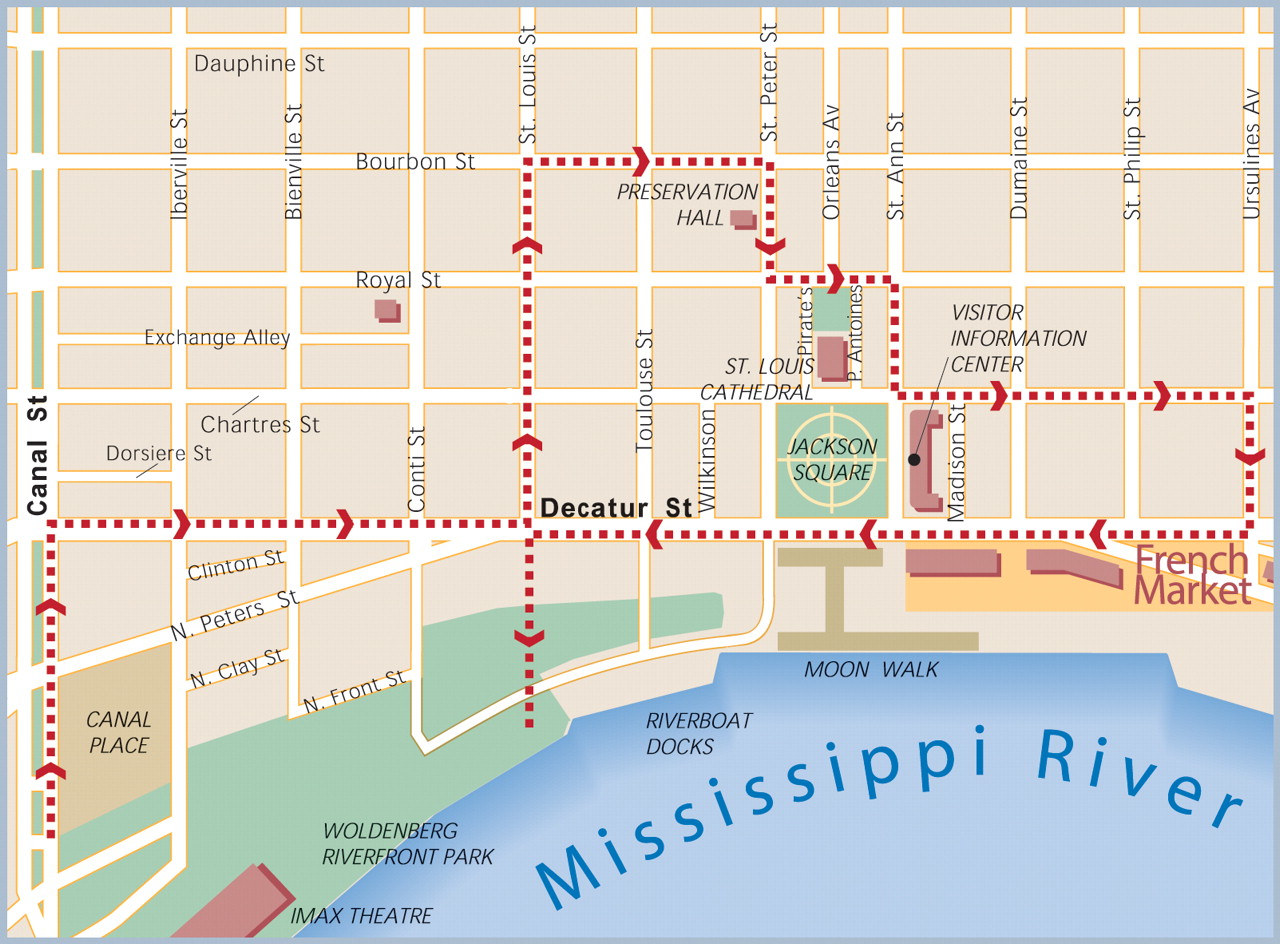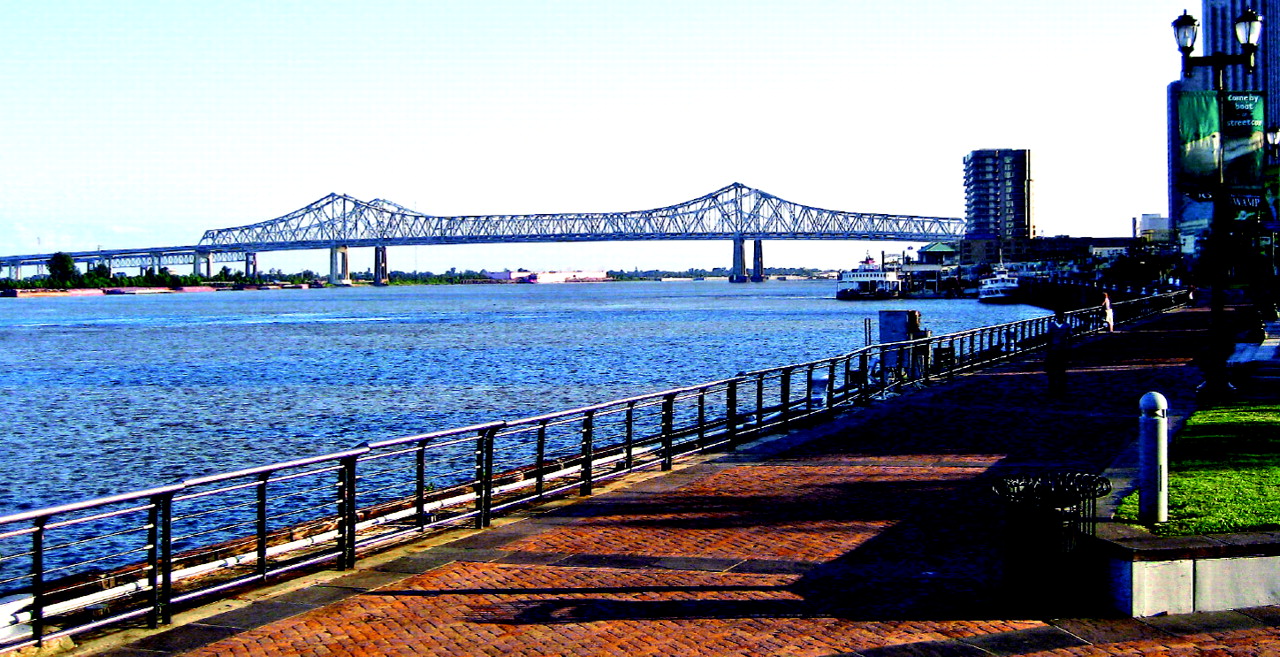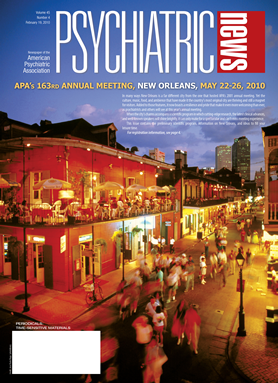Put on your walking shoes and get ready for a leisurely stroll when you come to New Orleans, because the city's famed French Quarter is made for seeing at a slow pace.
There are a number of vendors offering guided walking tours. And there is so much history in the Quarter—architectural, religious, musical, and literary—that visitors are liable to stumble across something interesting on their own; it would be all but impossible to encompass every site in the neighborhood.
But here is a sample itinerary, doable by everyone with some energy and a pair of comfortable shoes (and maybe a water bottle and a sunhat).
Begin on Canal Street down by the Mississippi River at the Canal Street Ferry. Also known as the Algiers Ferry, it carries automobiles and pedestrians across the river from the west bank at Canal Street to the historic Algiers Point neighborhood on the east bank of the river.
Walking north on Canal Street you'll pass the Shops at Canal Street, offering high-end fashion and jewelry shopping. Turn right at Decatur Street, and you will find a number of New Orleans' renowned music venues, including House of Blues and the Louisiana Music Factory. Between Conti and St. Louis streets, you will also come across the Visitors Center for the Jean Lafitte National Historical Park and Preserve.
The Visitors Center shares the history and traditions of the city and the delta through exhibits and film, and the national park encompasses five other landmarks of architectural, historical, or natural importance throughout southern Louisiana.
Next on the itinerary is a left turn on St. Louis Street followed by a three-block walk to Bourbon Street. A walk up and down Bourbon is a unique only-in-the Big-Easy experience—jazz and blues joints, bars that spill out onto the street, street performers, shopping (mostly of the low-end variety), and lots of people watching. In either direction on Bourbon are any number of music venues—the Famous Door, Fat Catz Music Club, the Cajun Cabin, Cat's Meow, and Fritzel's European Jazz Club.
Walking east on Bourbon (to the right after you've turned off of St. Louis), go two blocks to St. Peter Street and turn right. At 726 St. Peter is Preservation Hall, home to the world-renowned Preservation Hall Jazz Band and other elite acts dedicated to preserving the heritage of New Orleans jazz music.
Follow St. Peter Street to Jackson Square. Also known as Place des Armes, the square served as the center of early New Orleans and was renamed for Andrew Jackson following the Battle of New Orleans in 1814. There, Jackson commanded American troops and defeated the invading British, who were intent on capturing New Orleans and the enormous territory of the Louisiana Purchase.
Jackson Square is also home to the magnificent St. Louis Cathedral. First built in 1789 (it was rebuilt several times since then), the Basilica of St. Louis, King of France, is the oldest continually operating cathedral in the United States.
Travel around Jackson Square by turning left (east) on Royal Street, then right again on St. Ann as you walk along the eastern edge of the square. Turn left at Chartres Street and follow Chartres three blocks to Ursuline Street.
At Ursuline and Chartres, you will encounter the Old Ursuline Convent. A striking architectural landmark in its own right, it was built in 1752 and is believed to be the only surviving structure from the French Colonial period in America. Today it serves as an archive for the Archdiocese of New Orleans.
Continuing down Ursuline Street, turn right on Decatur Street again and head for the French Market. This open-air market has operated in one form or another since the late 1700s and today is a venue for shopping, entertainment, and regional cuisine. A little further down Decatur is Jimmy Buffett's Margaritaville, a lively venue for rock and R&B music.
To round out the tour, continue on Decatur past Jackson Square again and turn left at St. Peter Street, following it to the river.
To your left you'll see the Moon Walk, a scenic boardwalk along the Mississippi, built by former Mayor Moon Landrieu—a fine place to watch the steamboats and other river traffic.
Continuing along the bend in the river, you can end your walking tour at Woldenberg Park. A green and scenic venue, it's a great place to spread out a picnic blanket and rest up and contemplate the architectural and historic riches this one neighborhood offers.



